Organization Behaviour Report: Kotter's Model and Leadership Analysis
VerifiedAdded on 2022/09/12
|15
|3138
|27
Report
AI Summary
This report examines the organizational behavior of Bow Valley Energy, an oil and gas company undergoing a merger and facing internal challenges. The report focuses on change management, applying Kotter's eight-step model to address issues such as resistance to change and the need for a centralized decision-making structure. It outlines strategies for creating a sense of urgency, building a guiding coalition, communicating a clear vision, removing obstacles, and securing short-term wins. Furthermore, the report proposes the use of email and indoor meetings as communication channels to facilitate change and improve employee engagement. A transformational leadership model is also recommended to motivate employees and foster a positive environment. The report concludes by emphasizing the importance of proactive issue management to ensure the success of the change initiative.
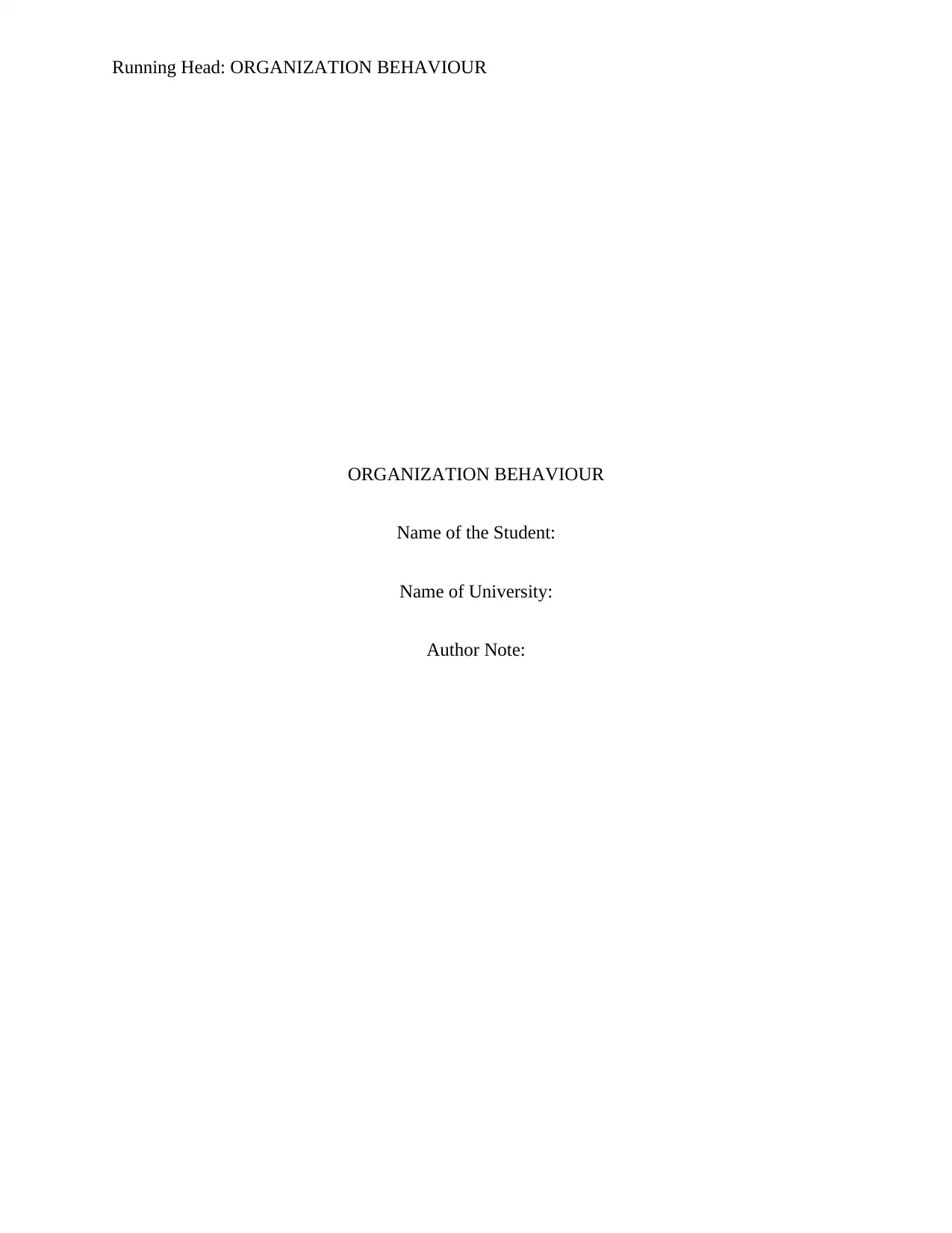
Running Head: ORGANIZATION BEHAVIOUR
ORGANIZATION BEHAVIOUR
Name of the Student:
Name of University:
Author Note:
ORGANIZATION BEHAVIOUR
Name of the Student:
Name of University:
Author Note:
Paraphrase This Document
Need a fresh take? Get an instant paraphrase of this document with our AI Paraphraser
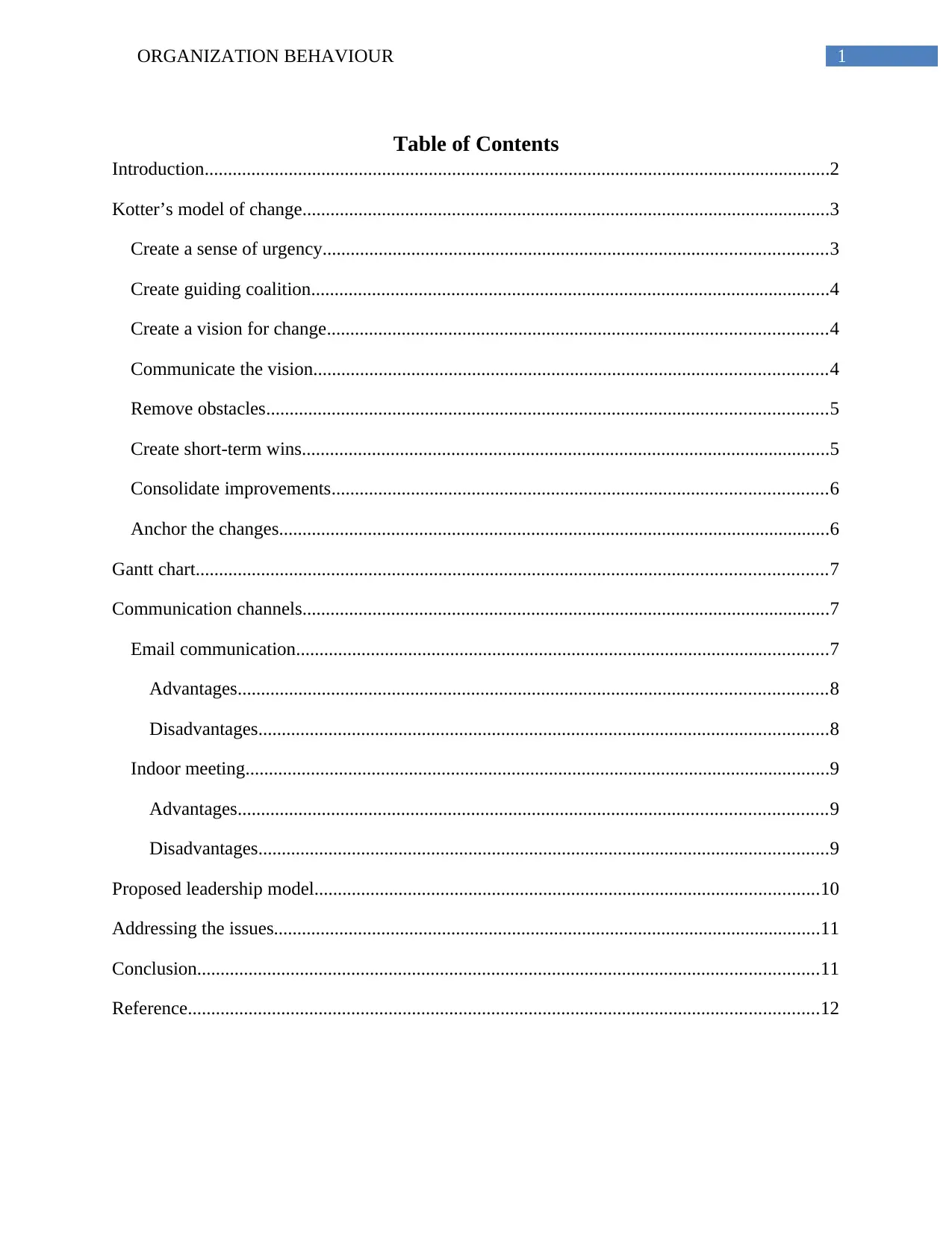
1ORGANIZATION BEHAVIOUR
Table of Contents
Introduction......................................................................................................................................2
Kotter’s model of change.................................................................................................................3
Create a sense of urgency............................................................................................................3
Create guiding coalition...............................................................................................................4
Create a vision for change...........................................................................................................4
Communicate the vision..............................................................................................................4
Remove obstacles........................................................................................................................5
Create short-term wins.................................................................................................................5
Consolidate improvements..........................................................................................................6
Anchor the changes......................................................................................................................6
Gantt chart.......................................................................................................................................7
Communication channels.................................................................................................................7
Email communication..................................................................................................................7
Advantages..............................................................................................................................8
Disadvantages..........................................................................................................................8
Indoor meeting.............................................................................................................................9
Advantages..............................................................................................................................9
Disadvantages..........................................................................................................................9
Proposed leadership model............................................................................................................10
Addressing the issues.....................................................................................................................11
Conclusion.....................................................................................................................................11
Reference.......................................................................................................................................12
Table of Contents
Introduction......................................................................................................................................2
Kotter’s model of change.................................................................................................................3
Create a sense of urgency............................................................................................................3
Create guiding coalition...............................................................................................................4
Create a vision for change...........................................................................................................4
Communicate the vision..............................................................................................................4
Remove obstacles........................................................................................................................5
Create short-term wins.................................................................................................................5
Consolidate improvements..........................................................................................................6
Anchor the changes......................................................................................................................6
Gantt chart.......................................................................................................................................7
Communication channels.................................................................................................................7
Email communication..................................................................................................................7
Advantages..............................................................................................................................8
Disadvantages..........................................................................................................................8
Indoor meeting.............................................................................................................................9
Advantages..............................................................................................................................9
Disadvantages..........................................................................................................................9
Proposed leadership model............................................................................................................10
Addressing the issues.....................................................................................................................11
Conclusion.....................................................................................................................................11
Reference.......................................................................................................................................12
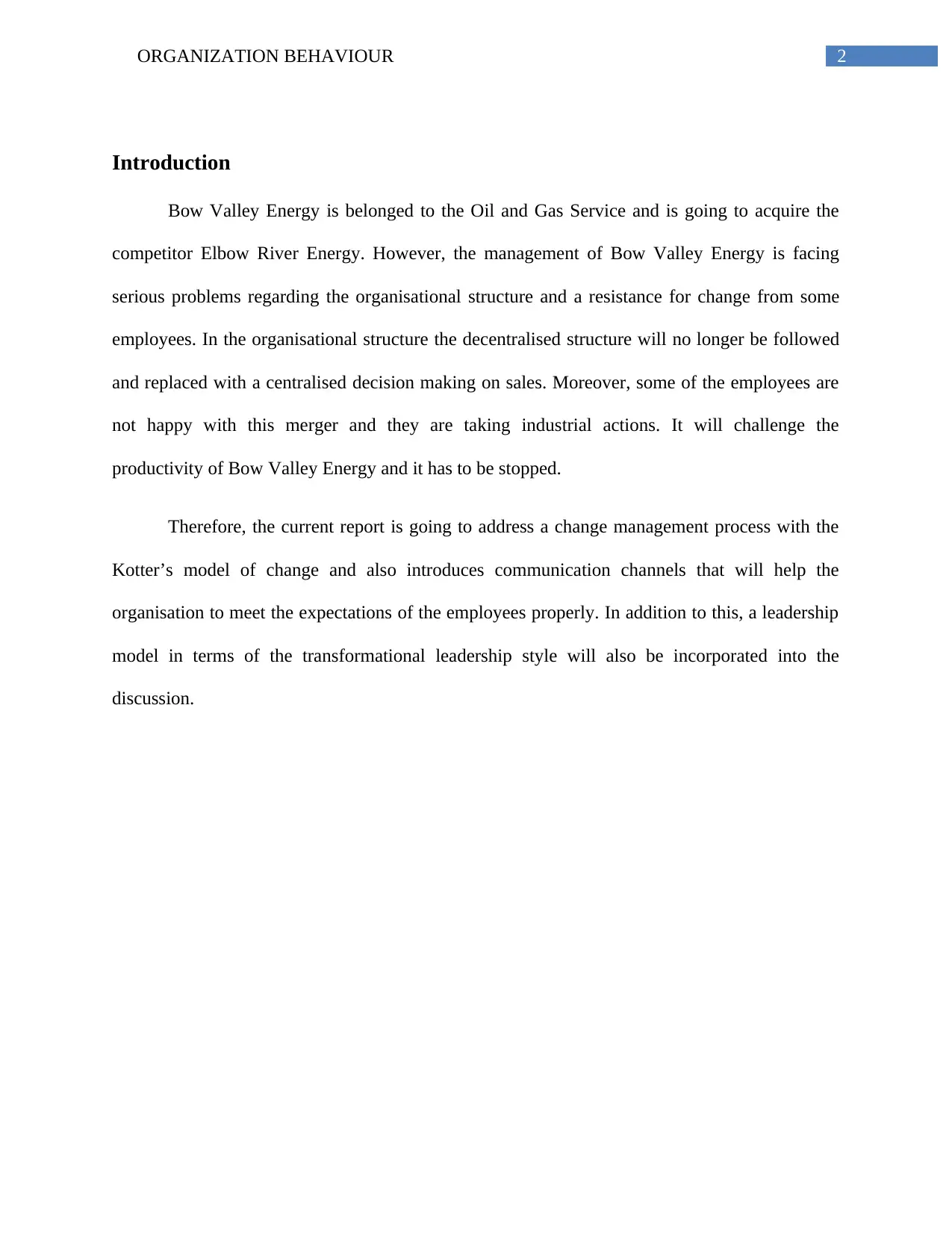
2ORGANIZATION BEHAVIOUR
Introduction
Bow Valley Energy is belonged to the Oil and Gas Service and is going to acquire the
competitor Elbow River Energy. However, the management of Bow Valley Energy is facing
serious problems regarding the organisational structure and a resistance for change from some
employees. In the organisational structure the decentralised structure will no longer be followed
and replaced with a centralised decision making on sales. Moreover, some of the employees are
not happy with this merger and they are taking industrial actions. It will challenge the
productivity of Bow Valley Energy and it has to be stopped.
Therefore, the current report is going to address a change management process with the
Kotter’s model of change and also introduces communication channels that will help the
organisation to meet the expectations of the employees properly. In addition to this, a leadership
model in terms of the transformational leadership style will also be incorporated into the
discussion.
Introduction
Bow Valley Energy is belonged to the Oil and Gas Service and is going to acquire the
competitor Elbow River Energy. However, the management of Bow Valley Energy is facing
serious problems regarding the organisational structure and a resistance for change from some
employees. In the organisational structure the decentralised structure will no longer be followed
and replaced with a centralised decision making on sales. Moreover, some of the employees are
not happy with this merger and they are taking industrial actions. It will challenge the
productivity of Bow Valley Energy and it has to be stopped.
Therefore, the current report is going to address a change management process with the
Kotter’s model of change and also introduces communication channels that will help the
organisation to meet the expectations of the employees properly. In addition to this, a leadership
model in terms of the transformational leadership style will also be incorporated into the
discussion.
⊘ This is a preview!⊘
Do you want full access?
Subscribe today to unlock all pages.

Trusted by 1+ million students worldwide
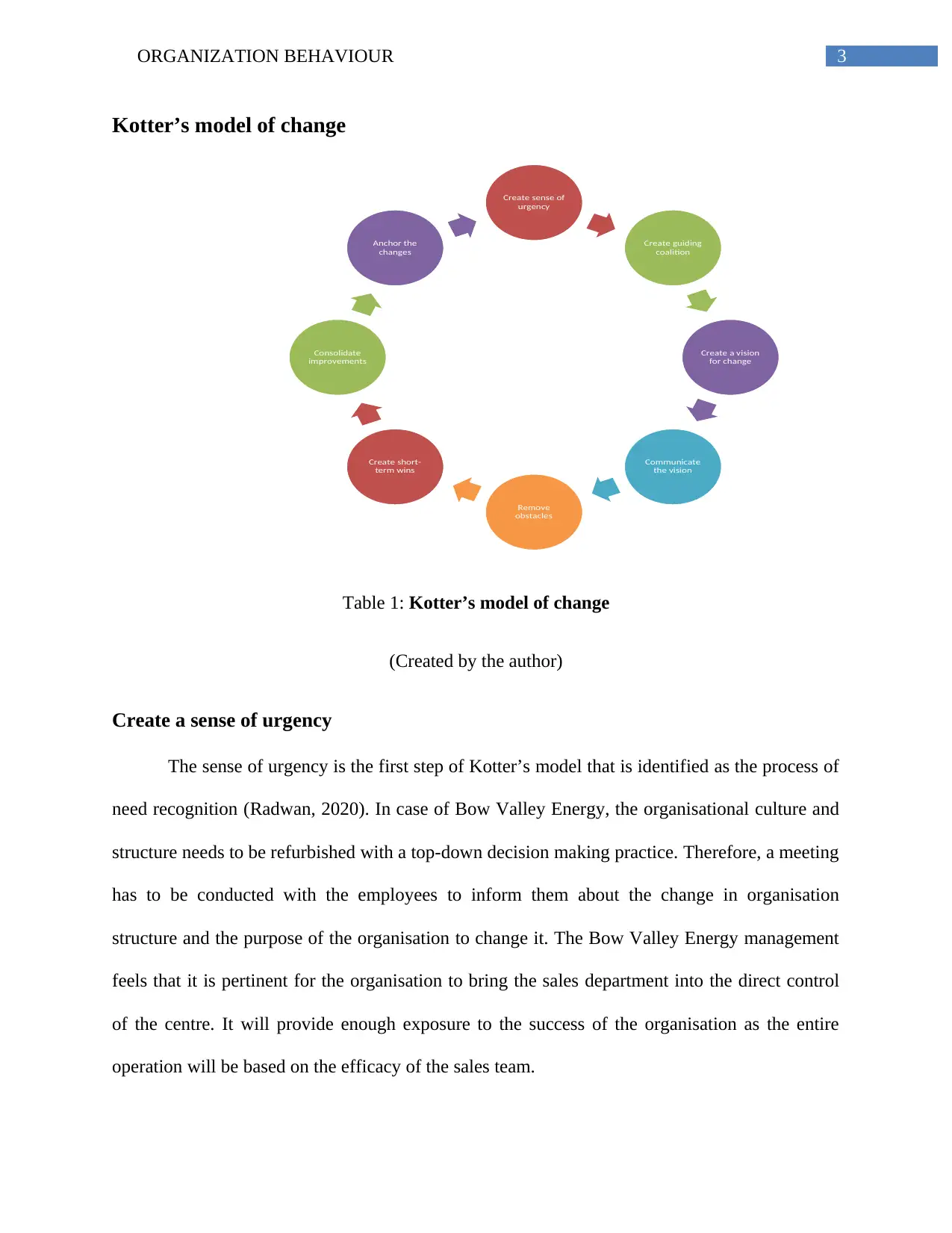
3ORGANIZATION BEHAVIOUR
Kotter’s model of change
Table 1: Kotter’s model of change
(Created by the author)
Create a sense of urgency
The sense of urgency is the first step of Kotter’s model that is identified as the process of
need recognition (Radwan, 2020). In case of Bow Valley Energy, the organisational culture and
structure needs to be refurbished with a top-down decision making practice. Therefore, a meeting
has to be conducted with the employees to inform them about the change in organisation
structure and the purpose of the organisation to change it. The Bow Valley Energy management
feels that it is pertinent for the organisation to bring the sales department into the direct control
of the centre. It will provide enough exposure to the success of the organisation as the entire
operation will be based on the efficacy of the sales team.
Create sense of
urgency
Create guiding
coalition
Create a vision
for change
Communicate
the vision
Remove
obstacles
Create short-
term wins
Consolidate
improvements
Anchor the
changes
Kotter’s model of change
Table 1: Kotter’s model of change
(Created by the author)
Create a sense of urgency
The sense of urgency is the first step of Kotter’s model that is identified as the process of
need recognition (Radwan, 2020). In case of Bow Valley Energy, the organisational culture and
structure needs to be refurbished with a top-down decision making practice. Therefore, a meeting
has to be conducted with the employees to inform them about the change in organisation
structure and the purpose of the organisation to change it. The Bow Valley Energy management
feels that it is pertinent for the organisation to bring the sales department into the direct control
of the centre. It will provide enough exposure to the success of the organisation as the entire
operation will be based on the efficacy of the sales team.
Create sense of
urgency
Create guiding
coalition
Create a vision
for change
Communicate
the vision
Remove
obstacles
Create short-
term wins
Consolidate
improvements
Anchor the
changes
Paraphrase This Document
Need a fresh take? Get an instant paraphrase of this document with our AI Paraphraser
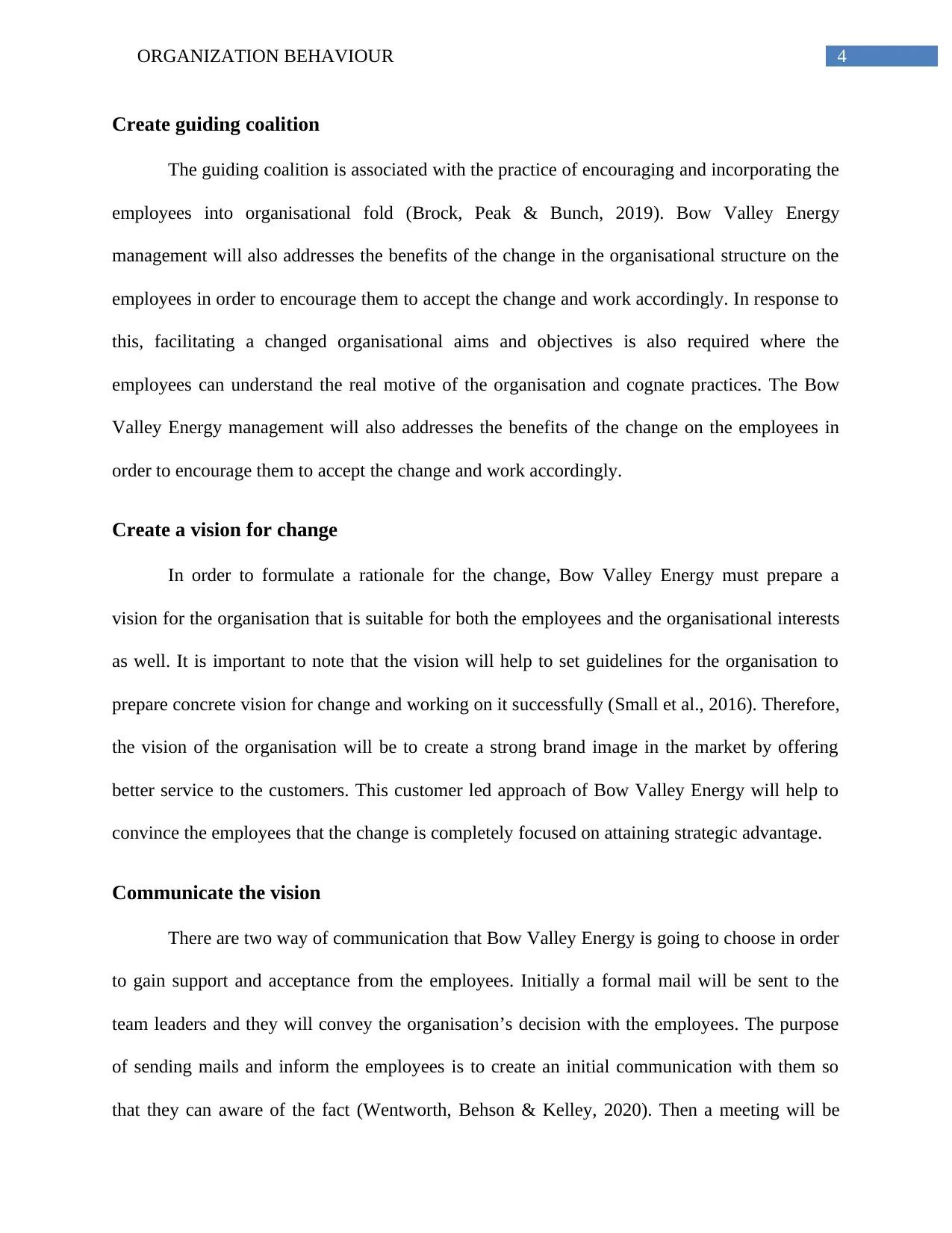
4ORGANIZATION BEHAVIOUR
Create guiding coalition
The guiding coalition is associated with the practice of encouraging and incorporating the
employees into organisational fold (Brock, Peak & Bunch, 2019). Bow Valley Energy
management will also addresses the benefits of the change in the organisational structure on the
employees in order to encourage them to accept the change and work accordingly. In response to
this, facilitating a changed organisational aims and objectives is also required where the
employees can understand the real motive of the organisation and cognate practices. The Bow
Valley Energy management will also addresses the benefits of the change on the employees in
order to encourage them to accept the change and work accordingly.
Create a vision for change
In order to formulate a rationale for the change, Bow Valley Energy must prepare a
vision for the organisation that is suitable for both the employees and the organisational interests
as well. It is important to note that the vision will help to set guidelines for the organisation to
prepare concrete vision for change and working on it successfully (Small et al., 2016). Therefore,
the vision of the organisation will be to create a strong brand image in the market by offering
better service to the customers. This customer led approach of Bow Valley Energy will help to
convince the employees that the change is completely focused on attaining strategic advantage.
Communicate the vision
There are two way of communication that Bow Valley Energy is going to choose in order
to gain support and acceptance from the employees. Initially a formal mail will be sent to the
team leaders and they will convey the organisation’s decision with the employees. The purpose
of sending mails and inform the employees is to create an initial communication with them so
that they can aware of the fact (Wentworth, Behson & Kelley, 2020). Then a meeting will be
Create guiding coalition
The guiding coalition is associated with the practice of encouraging and incorporating the
employees into organisational fold (Brock, Peak & Bunch, 2019). Bow Valley Energy
management will also addresses the benefits of the change in the organisational structure on the
employees in order to encourage them to accept the change and work accordingly. In response to
this, facilitating a changed organisational aims and objectives is also required where the
employees can understand the real motive of the organisation and cognate practices. The Bow
Valley Energy management will also addresses the benefits of the change on the employees in
order to encourage them to accept the change and work accordingly.
Create a vision for change
In order to formulate a rationale for the change, Bow Valley Energy must prepare a
vision for the organisation that is suitable for both the employees and the organisational interests
as well. It is important to note that the vision will help to set guidelines for the organisation to
prepare concrete vision for change and working on it successfully (Small et al., 2016). Therefore,
the vision of the organisation will be to create a strong brand image in the market by offering
better service to the customers. This customer led approach of Bow Valley Energy will help to
convince the employees that the change is completely focused on attaining strategic advantage.
Communicate the vision
There are two way of communication that Bow Valley Energy is going to choose in order
to gain support and acceptance from the employees. Initially a formal mail will be sent to the
team leaders and they will convey the organisation’s decision with the employees. The purpose
of sending mails and inform the employees is to create an initial communication with them so
that they can aware of the fact (Wentworth, Behson & Kelley, 2020). Then a meeting will be
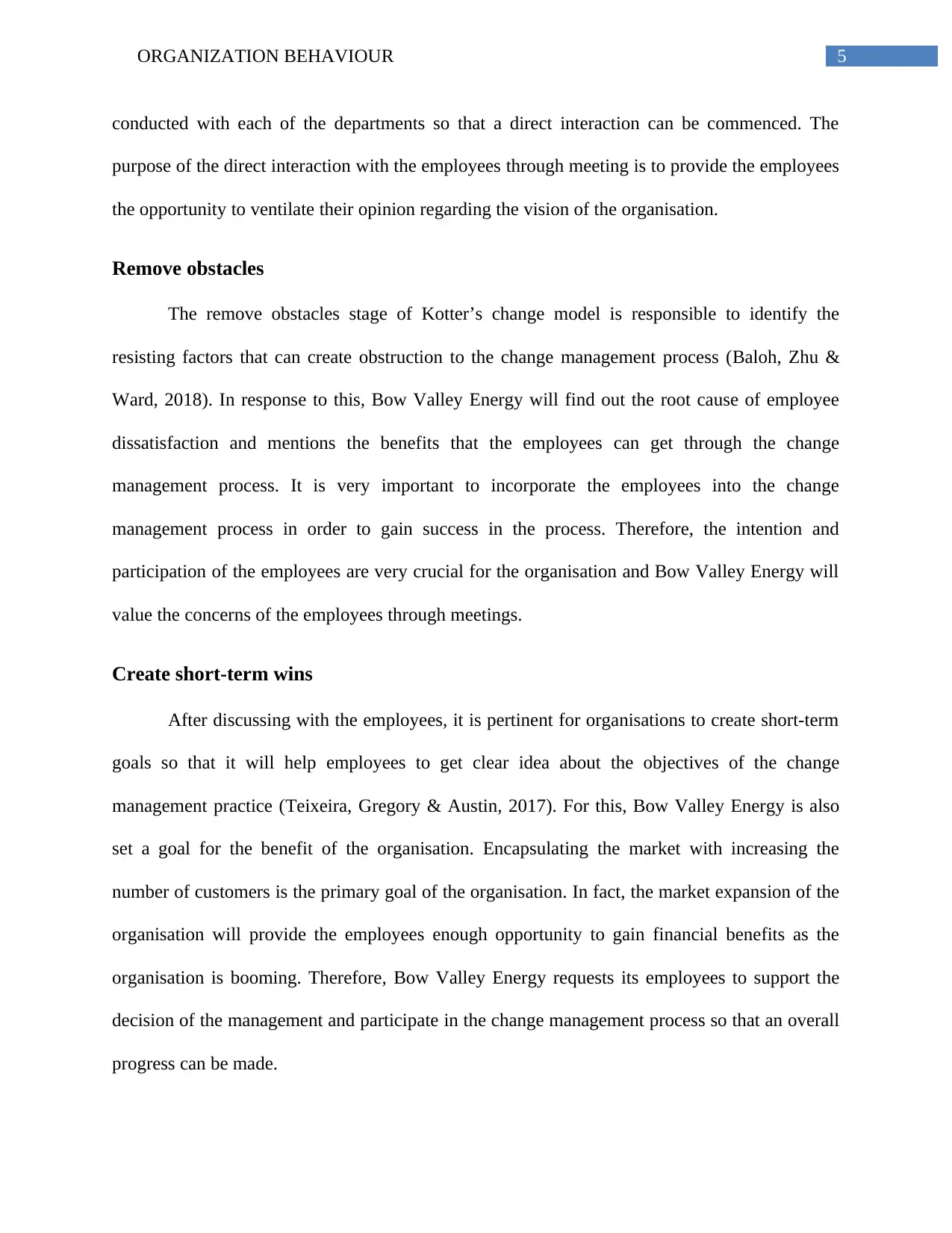
5ORGANIZATION BEHAVIOUR
conducted with each of the departments so that a direct interaction can be commenced. The
purpose of the direct interaction with the employees through meeting is to provide the employees
the opportunity to ventilate their opinion regarding the vision of the organisation.
Remove obstacles
The remove obstacles stage of Kotter’s change model is responsible to identify the
resisting factors that can create obstruction to the change management process (Baloh, Zhu &
Ward, 2018). In response to this, Bow Valley Energy will find out the root cause of employee
dissatisfaction and mentions the benefits that the employees can get through the change
management process. It is very important to incorporate the employees into the change
management process in order to gain success in the process. Therefore, the intention and
participation of the employees are very crucial for the organisation and Bow Valley Energy will
value the concerns of the employees through meetings.
Create short-term wins
After discussing with the employees, it is pertinent for organisations to create short-term
goals so that it will help employees to get clear idea about the objectives of the change
management practice (Teixeira, Gregory & Austin, 2017). For this, Bow Valley Energy is also
set a goal for the benefit of the organisation. Encapsulating the market with increasing the
number of customers is the primary goal of the organisation. In fact, the market expansion of the
organisation will provide the employees enough opportunity to gain financial benefits as the
organisation is booming. Therefore, Bow Valley Energy requests its employees to support the
decision of the management and participate in the change management process so that an overall
progress can be made.
conducted with each of the departments so that a direct interaction can be commenced. The
purpose of the direct interaction with the employees through meeting is to provide the employees
the opportunity to ventilate their opinion regarding the vision of the organisation.
Remove obstacles
The remove obstacles stage of Kotter’s change model is responsible to identify the
resisting factors that can create obstruction to the change management process (Baloh, Zhu &
Ward, 2018). In response to this, Bow Valley Energy will find out the root cause of employee
dissatisfaction and mentions the benefits that the employees can get through the change
management process. It is very important to incorporate the employees into the change
management process in order to gain success in the process. Therefore, the intention and
participation of the employees are very crucial for the organisation and Bow Valley Energy will
value the concerns of the employees through meetings.
Create short-term wins
After discussing with the employees, it is pertinent for organisations to create short-term
goals so that it will help employees to get clear idea about the objectives of the change
management practice (Teixeira, Gregory & Austin, 2017). For this, Bow Valley Energy is also
set a goal for the benefit of the organisation. Encapsulating the market with increasing the
number of customers is the primary goal of the organisation. In fact, the market expansion of the
organisation will provide the employees enough opportunity to gain financial benefits as the
organisation is booming. Therefore, Bow Valley Energy requests its employees to support the
decision of the management and participate in the change management process so that an overall
progress can be made.
⊘ This is a preview!⊘
Do you want full access?
Subscribe today to unlock all pages.

Trusted by 1+ million students worldwide
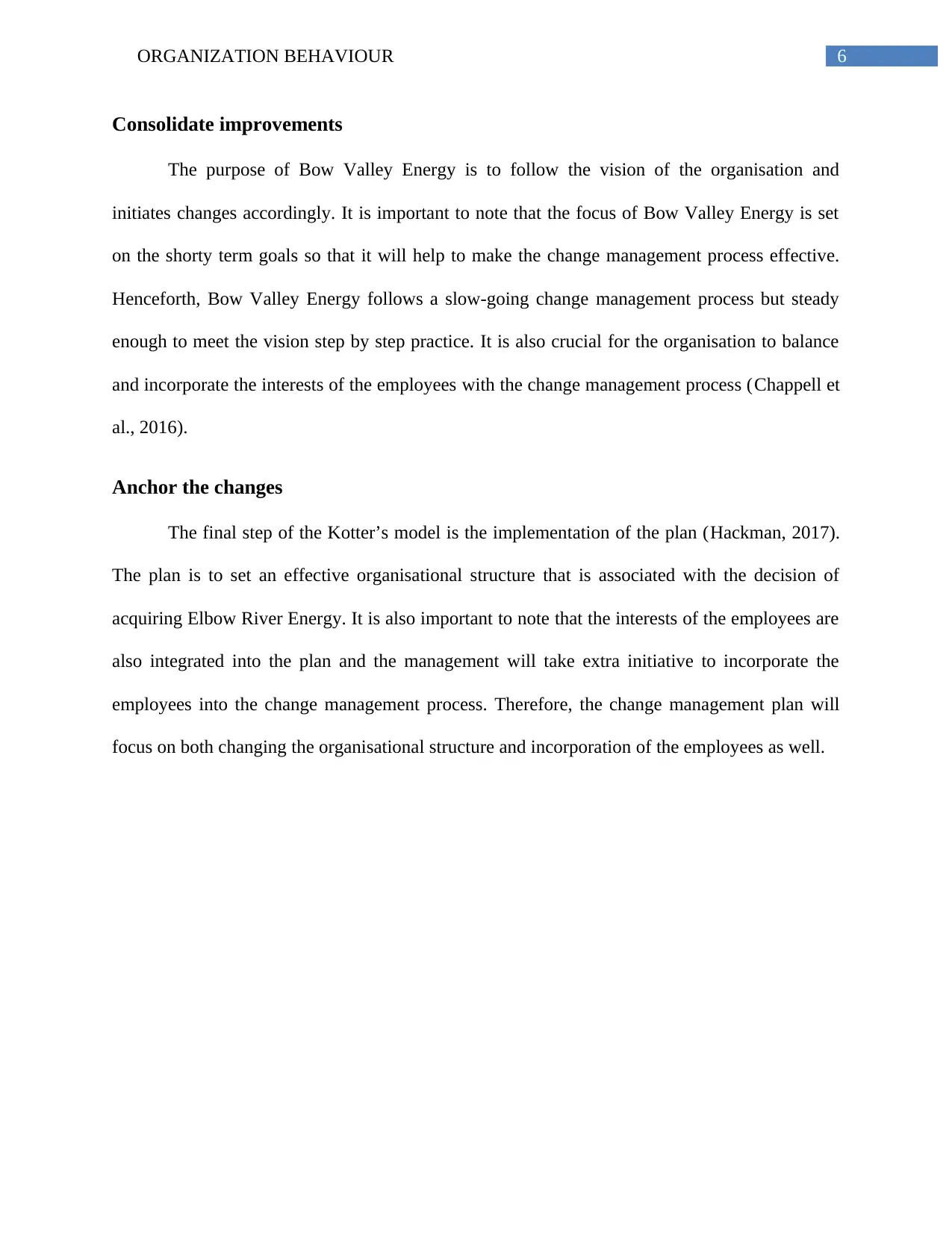
6ORGANIZATION BEHAVIOUR
Consolidate improvements
The purpose of Bow Valley Energy is to follow the vision of the organisation and
initiates changes accordingly. It is important to note that the focus of Bow Valley Energy is set
on the shorty term goals so that it will help to make the change management process effective.
Henceforth, Bow Valley Energy follows a slow-going change management process but steady
enough to meet the vision step by step practice. It is also crucial for the organisation to balance
and incorporate the interests of the employees with the change management process (Chappell et
al., 2016).
Anchor the changes
The final step of the Kotter’s model is the implementation of the plan (Hackman, 2017).
The plan is to set an effective organisational structure that is associated with the decision of
acquiring Elbow River Energy. It is also important to note that the interests of the employees are
also integrated into the plan and the management will take extra initiative to incorporate the
employees into the change management process. Therefore, the change management plan will
focus on both changing the organisational structure and incorporation of the employees as well.
Consolidate improvements
The purpose of Bow Valley Energy is to follow the vision of the organisation and
initiates changes accordingly. It is important to note that the focus of Bow Valley Energy is set
on the shorty term goals so that it will help to make the change management process effective.
Henceforth, Bow Valley Energy follows a slow-going change management process but steady
enough to meet the vision step by step practice. It is also crucial for the organisation to balance
and incorporate the interests of the employees with the change management process (Chappell et
al., 2016).
Anchor the changes
The final step of the Kotter’s model is the implementation of the plan (Hackman, 2017).
The plan is to set an effective organisational structure that is associated with the decision of
acquiring Elbow River Energy. It is also important to note that the interests of the employees are
also integrated into the plan and the management will take extra initiative to incorporate the
employees into the change management process. Therefore, the change management plan will
focus on both changing the organisational structure and incorporation of the employees as well.
Paraphrase This Document
Need a fresh take? Get an instant paraphrase of this document with our AI Paraphraser
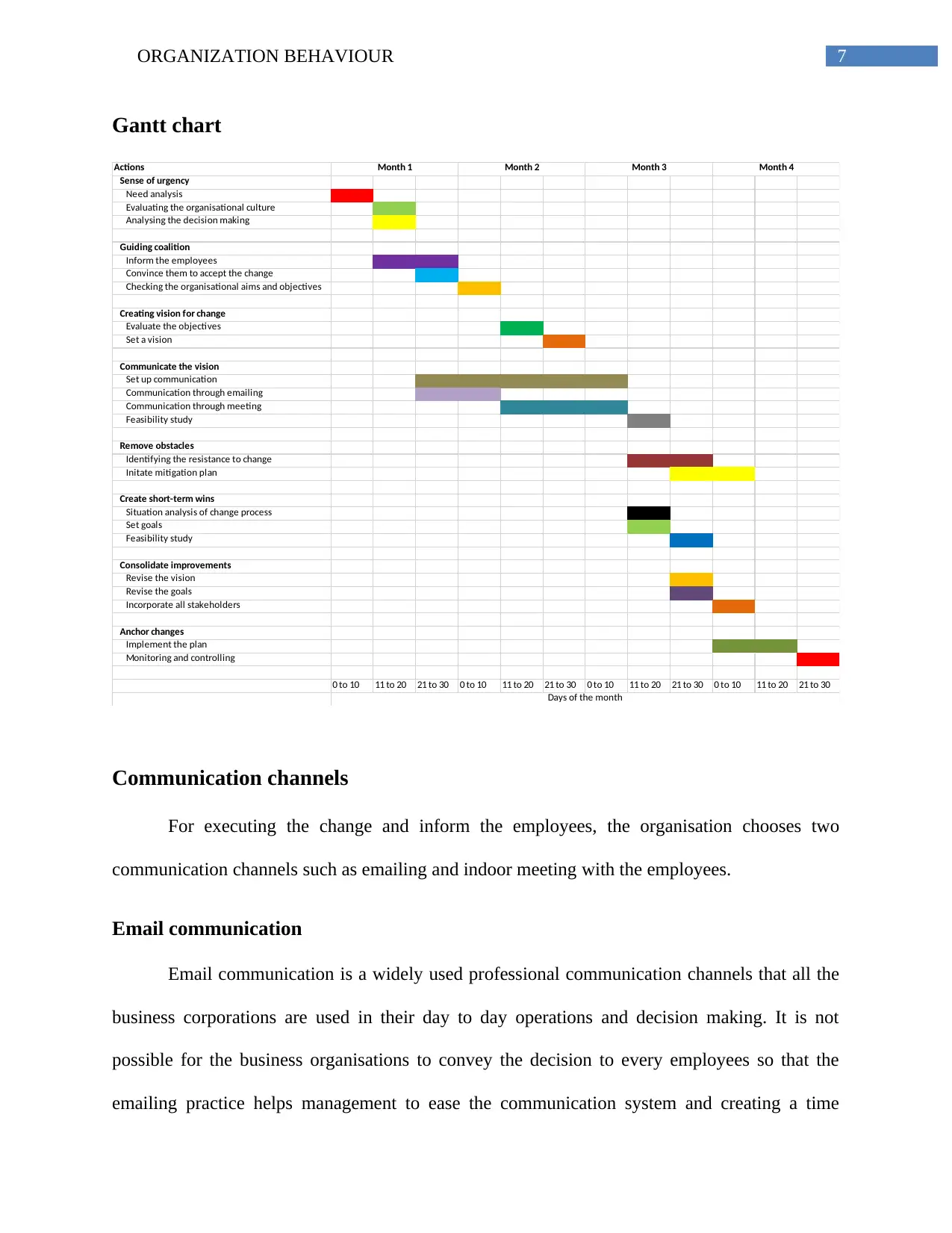
7ORGANIZATION BEHAVIOUR
Gantt chart
Actions
Sense of urgency
Need analysis
Evaluating the organisational culture
Analysing the decision making
Guiding coalition
Inform the employees
Convince them to accept the change
Checking the organisational aims and objectives
Creating vision for change
Evaluate the objectives
Set a vision
Communicate the vision
Set up communication
Communication through emailing
Communication through meeting
Feasibility study
Remove obstacles
Identifying the resistance to change
Initate mitigation plan
Create short-term wins
Situation analysis of change process
Set goals
Feasibility study
Consolidate improvements
Revise the vision
Revise the goals
Incorporate all stakeholders
Anchor changes
Implement the plan
Monitoring and controlling
0 to 10 11 to 20 21 to 30 0 to 10 11 to 20 21 to 30 0 to 10 11 to 20 21 to 30 0 to 10 11 to 20 21 to 30
Month 1 Month 2 Month 3 Month 4
Days of the month
Communication channels
For executing the change and inform the employees, the organisation chooses two
communication channels such as emailing and indoor meeting with the employees.
Email communication
Email communication is a widely used professional communication channels that all the
business corporations are used in their day to day operations and decision making. It is not
possible for the business organisations to convey the decision to every employees so that the
emailing practice helps management to ease the communication system and creating a time
Gantt chart
Actions
Sense of urgency
Need analysis
Evaluating the organisational culture
Analysing the decision making
Guiding coalition
Inform the employees
Convince them to accept the change
Checking the organisational aims and objectives
Creating vision for change
Evaluate the objectives
Set a vision
Communicate the vision
Set up communication
Communication through emailing
Communication through meeting
Feasibility study
Remove obstacles
Identifying the resistance to change
Initate mitigation plan
Create short-term wins
Situation analysis of change process
Set goals
Feasibility study
Consolidate improvements
Revise the vision
Revise the goals
Incorporate all stakeholders
Anchor changes
Implement the plan
Monitoring and controlling
0 to 10 11 to 20 21 to 30 0 to 10 11 to 20 21 to 30 0 to 10 11 to 20 21 to 30 0 to 10 11 to 20 21 to 30
Month 1 Month 2 Month 3 Month 4
Days of the month
Communication channels
For executing the change and inform the employees, the organisation chooses two
communication channels such as emailing and indoor meeting with the employees.
Email communication
Email communication is a widely used professional communication channels that all the
business corporations are used in their day to day operations and decision making. It is not
possible for the business organisations to convey the decision to every employees so that the
emailing practice helps management to ease the communication system and creating a time
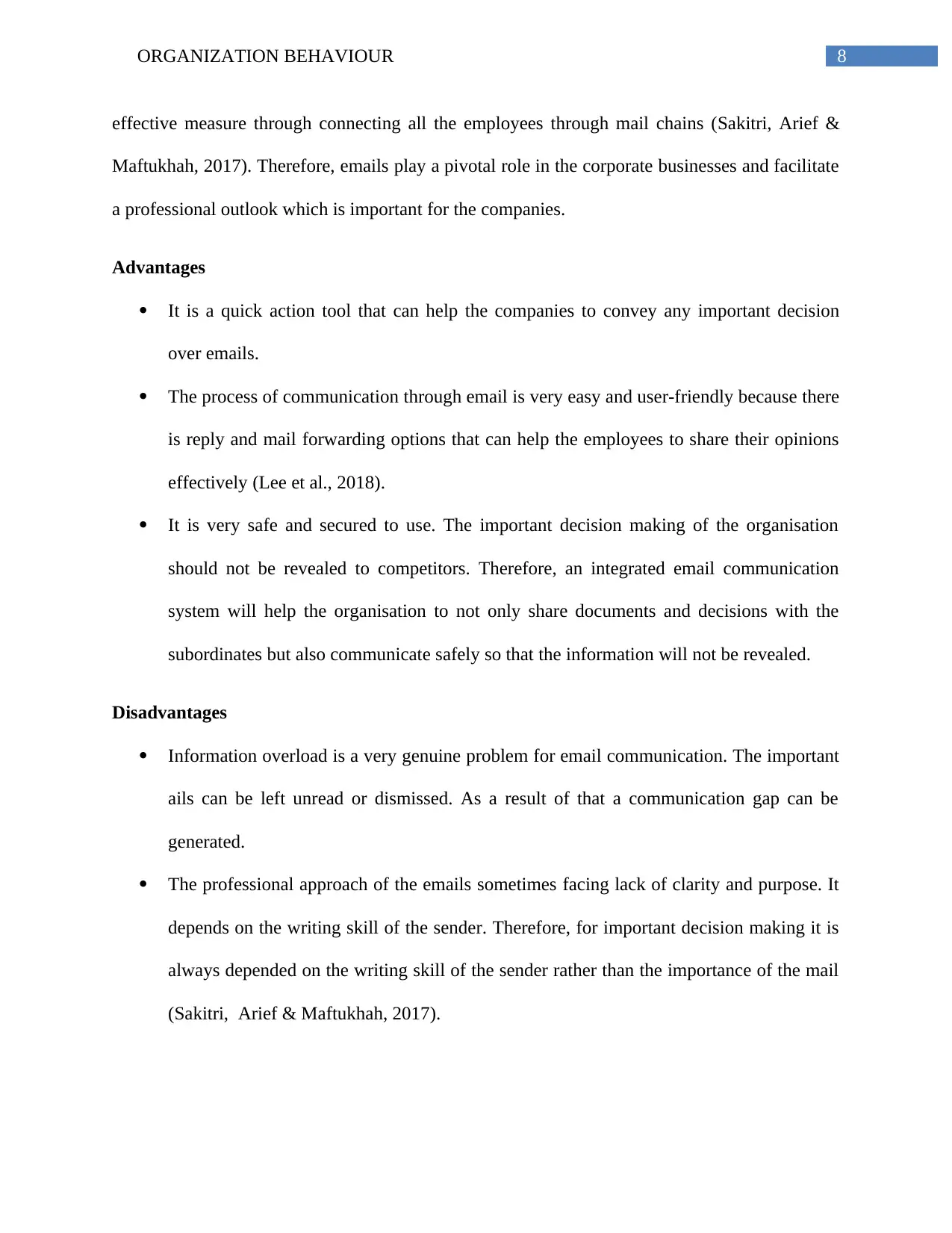
8ORGANIZATION BEHAVIOUR
effective measure through connecting all the employees through mail chains (Sakitri, Arief &
Maftukhah, 2017). Therefore, emails play a pivotal role in the corporate businesses and facilitate
a professional outlook which is important for the companies.
Advantages
It is a quick action tool that can help the companies to convey any important decision
over emails.
The process of communication through email is very easy and user-friendly because there
is reply and mail forwarding options that can help the employees to share their opinions
effectively (Lee et al., 2018).
It is very safe and secured to use. The important decision making of the organisation
should not be revealed to competitors. Therefore, an integrated email communication
system will help the organisation to not only share documents and decisions with the
subordinates but also communicate safely so that the information will not be revealed.
Disadvantages
Information overload is a very genuine problem for email communication. The important
ails can be left unread or dismissed. As a result of that a communication gap can be
generated.
The professional approach of the emails sometimes facing lack of clarity and purpose. It
depends on the writing skill of the sender. Therefore, for important decision making it is
always depended on the writing skill of the sender rather than the importance of the mail
(Sakitri, Arief & Maftukhah, 2017).
effective measure through connecting all the employees through mail chains (Sakitri, Arief &
Maftukhah, 2017). Therefore, emails play a pivotal role in the corporate businesses and facilitate
a professional outlook which is important for the companies.
Advantages
It is a quick action tool that can help the companies to convey any important decision
over emails.
The process of communication through email is very easy and user-friendly because there
is reply and mail forwarding options that can help the employees to share their opinions
effectively (Lee et al., 2018).
It is very safe and secured to use. The important decision making of the organisation
should not be revealed to competitors. Therefore, an integrated email communication
system will help the organisation to not only share documents and decisions with the
subordinates but also communicate safely so that the information will not be revealed.
Disadvantages
Information overload is a very genuine problem for email communication. The important
ails can be left unread or dismissed. As a result of that a communication gap can be
generated.
The professional approach of the emails sometimes facing lack of clarity and purpose. It
depends on the writing skill of the sender. Therefore, for important decision making it is
always depended on the writing skill of the sender rather than the importance of the mail
(Sakitri, Arief & Maftukhah, 2017).
⊘ This is a preview!⊘
Do you want full access?
Subscribe today to unlock all pages.

Trusted by 1+ million students worldwide
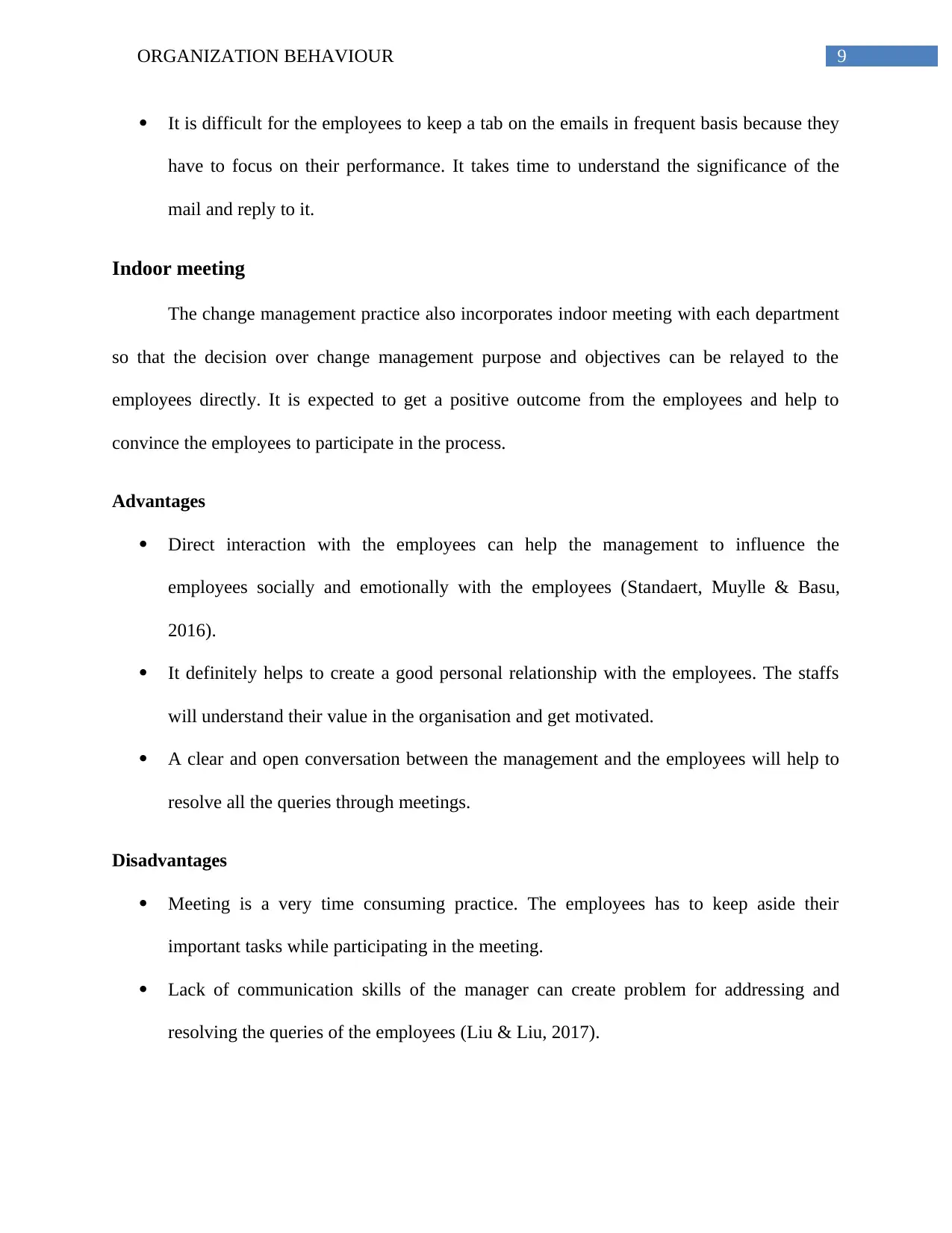
9ORGANIZATION BEHAVIOUR
It is difficult for the employees to keep a tab on the emails in frequent basis because they
have to focus on their performance. It takes time to understand the significance of the
mail and reply to it.
Indoor meeting
The change management practice also incorporates indoor meeting with each department
so that the decision over change management purpose and objectives can be relayed to the
employees directly. It is expected to get a positive outcome from the employees and help to
convince the employees to participate in the process.
Advantages
Direct interaction with the employees can help the management to influence the
employees socially and emotionally with the employees (Standaert, Muylle & Basu,
2016).
It definitely helps to create a good personal relationship with the employees. The staffs
will understand their value in the organisation and get motivated.
A clear and open conversation between the management and the employees will help to
resolve all the queries through meetings.
Disadvantages
Meeting is a very time consuming practice. The employees has to keep aside their
important tasks while participating in the meeting.
Lack of communication skills of the manager can create problem for addressing and
resolving the queries of the employees (Liu & Liu, 2017).
It is difficult for the employees to keep a tab on the emails in frequent basis because they
have to focus on their performance. It takes time to understand the significance of the
mail and reply to it.
Indoor meeting
The change management practice also incorporates indoor meeting with each department
so that the decision over change management purpose and objectives can be relayed to the
employees directly. It is expected to get a positive outcome from the employees and help to
convince the employees to participate in the process.
Advantages
Direct interaction with the employees can help the management to influence the
employees socially and emotionally with the employees (Standaert, Muylle & Basu,
2016).
It definitely helps to create a good personal relationship with the employees. The staffs
will understand their value in the organisation and get motivated.
A clear and open conversation between the management and the employees will help to
resolve all the queries through meetings.
Disadvantages
Meeting is a very time consuming practice. The employees has to keep aside their
important tasks while participating in the meeting.
Lack of communication skills of the manager can create problem for addressing and
resolving the queries of the employees (Liu & Liu, 2017).
Paraphrase This Document
Need a fresh take? Get an instant paraphrase of this document with our AI Paraphraser
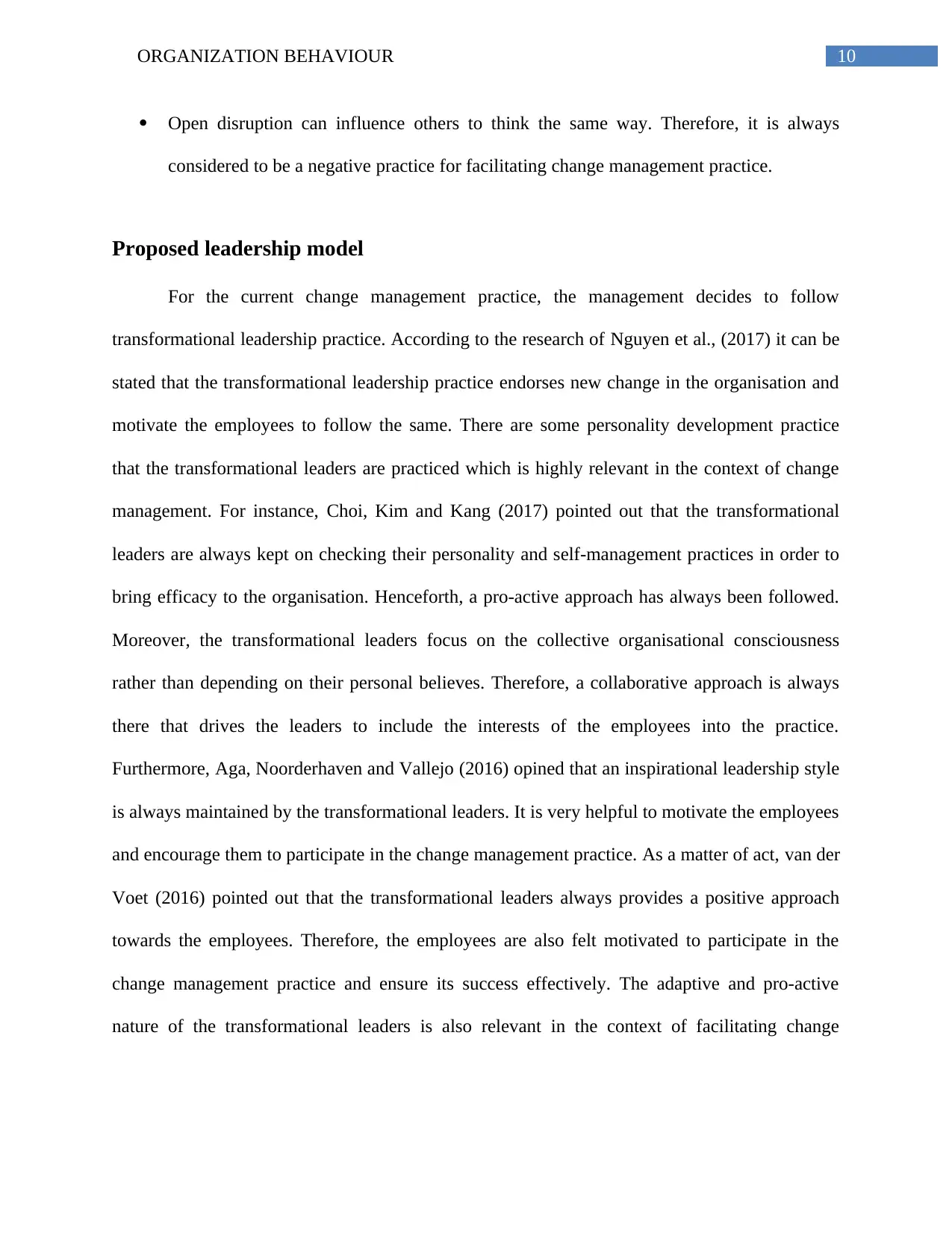
10ORGANIZATION BEHAVIOUR
Open disruption can influence others to think the same way. Therefore, it is always
considered to be a negative practice for facilitating change management practice.
Proposed leadership model
For the current change management practice, the management decides to follow
transformational leadership practice. According to the research of Nguyen et al., (2017) it can be
stated that the transformational leadership practice endorses new change in the organisation and
motivate the employees to follow the same. There are some personality development practice
that the transformational leaders are practiced which is highly relevant in the context of change
management. For instance, Choi, Kim and Kang (2017) pointed out that the transformational
leaders are always kept on checking their personality and self-management practices in order to
bring efficacy to the organisation. Henceforth, a pro-active approach has always been followed.
Moreover, the transformational leaders focus on the collective organisational consciousness
rather than depending on their personal believes. Therefore, a collaborative approach is always
there that drives the leaders to include the interests of the employees into the practice.
Furthermore, Aga, Noorderhaven and Vallejo (2016) opined that an inspirational leadership style
is always maintained by the transformational leaders. It is very helpful to motivate the employees
and encourage them to participate in the change management practice. As a matter of act, van der
Voet (2016) pointed out that the transformational leaders always provides a positive approach
towards the employees. Therefore, the employees are also felt motivated to participate in the
change management practice and ensure its success effectively. The adaptive and pro-active
nature of the transformational leaders is also relevant in the context of facilitating change
Open disruption can influence others to think the same way. Therefore, it is always
considered to be a negative practice for facilitating change management practice.
Proposed leadership model
For the current change management practice, the management decides to follow
transformational leadership practice. According to the research of Nguyen et al., (2017) it can be
stated that the transformational leadership practice endorses new change in the organisation and
motivate the employees to follow the same. There are some personality development practice
that the transformational leaders are practiced which is highly relevant in the context of change
management. For instance, Choi, Kim and Kang (2017) pointed out that the transformational
leaders are always kept on checking their personality and self-management practices in order to
bring efficacy to the organisation. Henceforth, a pro-active approach has always been followed.
Moreover, the transformational leaders focus on the collective organisational consciousness
rather than depending on their personal believes. Therefore, a collaborative approach is always
there that drives the leaders to include the interests of the employees into the practice.
Furthermore, Aga, Noorderhaven and Vallejo (2016) opined that an inspirational leadership style
is always maintained by the transformational leaders. It is very helpful to motivate the employees
and encourage them to participate in the change management practice. As a matter of act, van der
Voet (2016) pointed out that the transformational leaders always provides a positive approach
towards the employees. Therefore, the employees are also felt motivated to participate in the
change management practice and ensure its success effectively. The adaptive and pro-active
nature of the transformational leaders is also relevant in the context of facilitating change
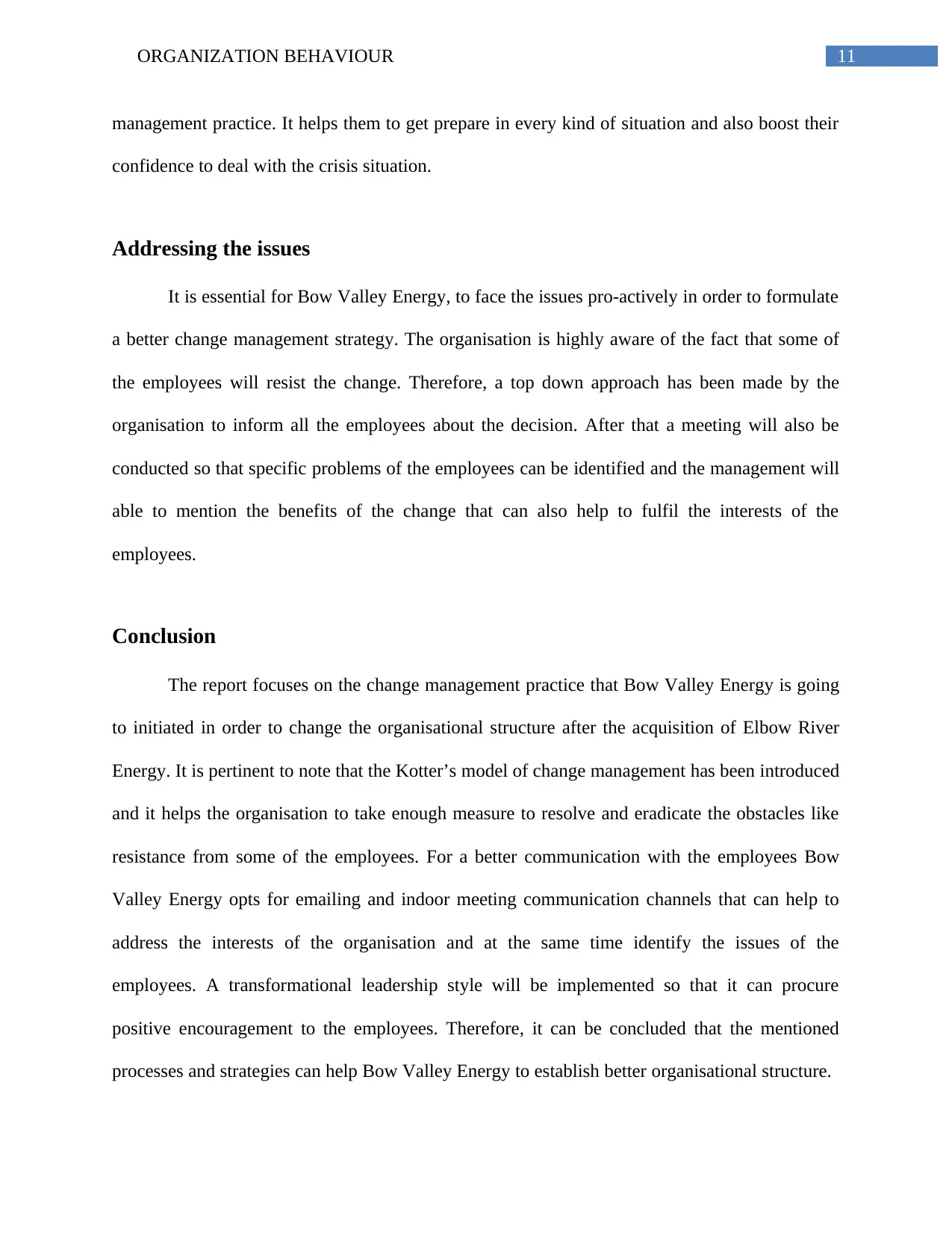
11ORGANIZATION BEHAVIOUR
management practice. It helps them to get prepare in every kind of situation and also boost their
confidence to deal with the crisis situation.
Addressing the issues
It is essential for Bow Valley Energy, to face the issues pro-actively in order to formulate
a better change management strategy. The organisation is highly aware of the fact that some of
the employees will resist the change. Therefore, a top down approach has been made by the
organisation to inform all the employees about the decision. After that a meeting will also be
conducted so that specific problems of the employees can be identified and the management will
able to mention the benefits of the change that can also help to fulfil the interests of the
employees.
Conclusion
The report focuses on the change management practice that Bow Valley Energy is going
to initiated in order to change the organisational structure after the acquisition of Elbow River
Energy. It is pertinent to note that the Kotter’s model of change management has been introduced
and it helps the organisation to take enough measure to resolve and eradicate the obstacles like
resistance from some of the employees. For a better communication with the employees Bow
Valley Energy opts for emailing and indoor meeting communication channels that can help to
address the interests of the organisation and at the same time identify the issues of the
employees. A transformational leadership style will be implemented so that it can procure
positive encouragement to the employees. Therefore, it can be concluded that the mentioned
processes and strategies can help Bow Valley Energy to establish better organisational structure.
management practice. It helps them to get prepare in every kind of situation and also boost their
confidence to deal with the crisis situation.
Addressing the issues
It is essential for Bow Valley Energy, to face the issues pro-actively in order to formulate
a better change management strategy. The organisation is highly aware of the fact that some of
the employees will resist the change. Therefore, a top down approach has been made by the
organisation to inform all the employees about the decision. After that a meeting will also be
conducted so that specific problems of the employees can be identified and the management will
able to mention the benefits of the change that can also help to fulfil the interests of the
employees.
Conclusion
The report focuses on the change management practice that Bow Valley Energy is going
to initiated in order to change the organisational structure after the acquisition of Elbow River
Energy. It is pertinent to note that the Kotter’s model of change management has been introduced
and it helps the organisation to take enough measure to resolve and eradicate the obstacles like
resistance from some of the employees. For a better communication with the employees Bow
Valley Energy opts for emailing and indoor meeting communication channels that can help to
address the interests of the organisation and at the same time identify the issues of the
employees. A transformational leadership style will be implemented so that it can procure
positive encouragement to the employees. Therefore, it can be concluded that the mentioned
processes and strategies can help Bow Valley Energy to establish better organisational structure.
⊘ This is a preview!⊘
Do you want full access?
Subscribe today to unlock all pages.

Trusted by 1+ million students worldwide
1 out of 15
Related Documents
Your All-in-One AI-Powered Toolkit for Academic Success.
+13062052269
info@desklib.com
Available 24*7 on WhatsApp / Email
![[object Object]](/_next/static/media/star-bottom.7253800d.svg)
Unlock your academic potential
Copyright © 2020–2025 A2Z Services. All Rights Reserved. Developed and managed by ZUCOL.





